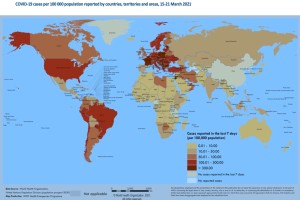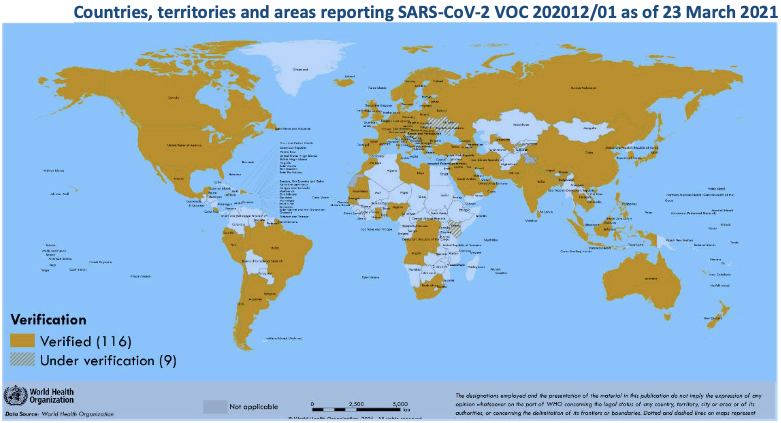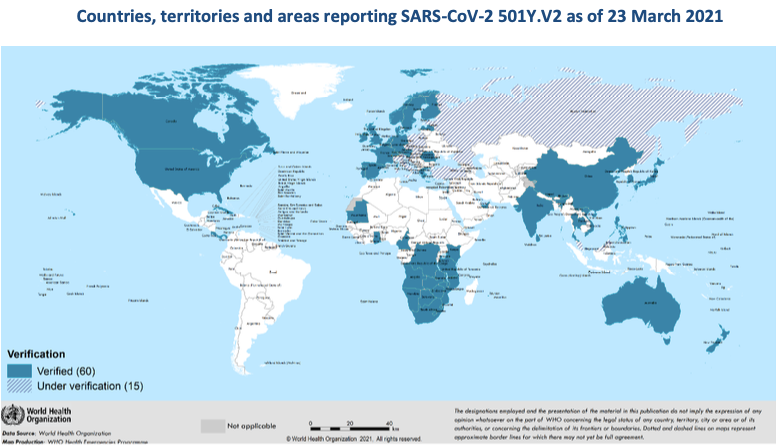
Variants of Concerns now showing higher risk of mortality
Geneva: Globally, COVID-19 confirmed cases has continued to rise for a fourth consecutive week. Weekly figures based on data from national authorities showed about 3.3 million new cases reported during the week ending March 21, 2021, the World Health Organisation stated today.
The highest numbers of new cases were reported from Brazil (508 010 new cases; 3% increase), the United States of America (374 369 new cases; 19% decrease), India (240 082 new cases; 62% increase), France (204 840 new cases; 27% increase), and Italy (154 493 new cases; similar to previous week).
Concurrently, figures showed, the number of new deaths reported plateaued after a six week decrease, with over 60 000 new deaths reported.
A marked increase in the number of new cases was reported from the WHO regions South East Asia (that includes India), Western Pacific, European and Eastern Mediterranean, all of which are on an upward trajectory in recent weeks.
The WHO South-East Asia Region reported over 298 000 new cases and over 2400 new deaths, a 49% and a 14% increase respectively compared to the previous week. Eighty per cent of all new cases were reported from India. The highest numbers of new cases were reported from India (240 082 new cases; 17.4 new cases per 100 000; a 62% increase), Indonesia (41 047 new cases; 15.0 new cases per 100 000; similar to the previous week), and Bangladesh (12 470 new cases; 7.6 new cases per 100 000; a 91% increase). The same countries reported the highest numbers of new deaths in the region; India (1148 new deaths; 0.1 new deaths per 100 000; a 35% increase), Indonesia (1118 new deaths; 0.4 new deaths per 100 000; a 5% decrease), and Bangladesh (141 new deaths; 0.1 new deaths per 100 000; an 86% increase).
The European Region and the Region of the Americas continued to account for nearly 80% of all the cases and deaths.
The only WHO region to report a decline in new deaths this week was the Western Pacific where deaths fell by nearly a third, compared to the previous week.

The number of countries reporting Variants Of Concerns (VOCs) too has continued to increase.
“Since our last update on 16 March, VOC 202012/01 has been detected in seven additional countries. As of 23 March, a total of 125 countries across all six WHO regions have reported cases of this variant,” the WHO stated, and warned that while earlier studies that showed VOC 202012/01 may be associated with an increased risk of hospitalization, severity and mortality, recent studies now provide additional evidence highlighting that there is a higher risk of mortality when infected by VOC 202012/01.

Since the last update on 16 March, 501Y.V2 too has been reported from 11 additional countries – totaling 75 countries across all six WHO regions and latest studies have shown that the risk of in-hospital mortality too has increased by 20% in case of variant 501Y.V2.

So far as variant P.1 was concerned, since the last update, this variant has been reported in three additional countries. As of March 23, 2021 this variant was reported in 41 countries across all six WHO regions. Based on the preliminary findings, P.1 is now found to be 2.5 times more transmissible compared to the previously circulating variant and the WHO said more studies were required to fully understand the transmissibility and severity of P.1 variant.

The WHO said VOC 202012/01, 501Y.V2 and P.1 have commonly demonstrated an increase in transmissibility compared to wild-type (non-VOC) variants, and a veracity to rapidly replace other circulating strains. These COVID-19 Variants Of Concerns have rapidly replaced the wild-type variant in the United Kingdom, South Africa and Brazil, the WHO said, adding that the transmissibility of P.1 was higher when estimated only for the Amazonas region of Brazil, suggesting more rapid replacement of the wild-type variant at a local level.
– global bihari bureau





